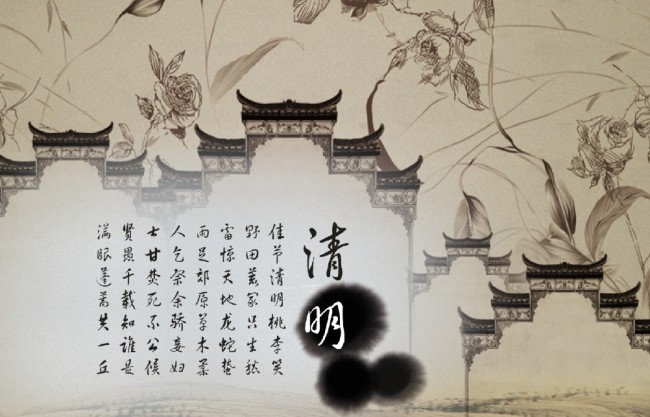|
Tomb Sweeping 扫墓
The major custom in Qingming Festival is tomb sweeping. On this day, people visit their family graves to remove any underbrush that has grown. They would uproot weeds near the gravesites, wipe the tombstones and decorate the tombstones with fresh flowers. And then they will set out offerings of food and paper money.
清明节的主要习俗是扫墓。在这一天,人们都会前往他们的家族墓地进行拜祭。他们会铲除墓地周围的杂草,擦拭墓碑,以及用鲜花装饰墓碑。然后,放置贡品和烧纸钱。
Spring Outing 春游、踏青
Not only it is a day for commemorating the dead, is it also a festival for people to enjoy themselves. During March, everything in nature takes on a new look, as trees turn green, flowers blossom, and the sun shines brightly. It is a fine time to go out and to appreciate the beautiful scenes of nature during the festival. Spring outings not only add joy to life but also promote a healthy body and mind.
清明节不仅仅是一个纪念故人的节日,人们也可以在这一天进行娱乐活动。在3月份,大自然焕然一新,树木变绿,花朵绽放,阳光普照。节日期间,大家可以好好地去感受一下自然的魅力。春游不仅能给生活带来愉悦,同时也可以促进身体和心灵的健康。

Flying Kites 放风筝
Flying kites is an activity favored by many people during the Qingming Festival. Kites are not only flown at day time but also in the evening. Little lanterns are tied to the kite or to the string that holds the kite. And when the kite is flying in the sky, the lanterns look like twinkling stars that add unique scenery to the sky during the night. What makes flying kites during this festival special is that people cut the string while the kite is in the sky to let it fly free. It is said that this brings good luck and that diseases can be eliminated by doing this.
在清明节期间,许多人都喜欢放风筝,无论白天还是晚上。将小灯笼系在风筝或放风筝的绳子上,当风筝在空中飞舞时,灯笼看起来像闪烁的星星,会给夜晚的天空增加一些独特的风景。清明节放风筝的特别之处,是当风筝被放飞到高空时,人们会将风筝线剪段,让它自由飞翔,据说这样可以带来好运和消除疾病。
Planting Willow Trees 插柳
Because Jie Zitui died embracing a willow tree, the willow is believed to have miraculous powers against evil. During the Qingming Festival, willow branches are hung on door fronts and used to sweep the tombs.
因为介子推死的时候抱着一棵柳树,所以柳树被认为拥有一种可以对抗邪恶的神奇力量。清明时节,人们会将柳枝挂在门前,或拿柳枝进行扫墓。
Swinging 荡秋千
During the Ming Dynasty, swinging was a designated recreation on Tomb Sweeping Festival. According to the Annals of the Ming Court, this day was also called Swing Festival, when swings were suspended in the Hall of the Forbidden City and in all the residential complexes where palace ladies resided. Ladies of the imperial household wore colorful silks especially made for the occasion, and amused themselves on swings.
明朝期间,荡秋千是清明节的一个指定的娱乐活动。根据明朝的史册记载,清明节也被称为秋千节,这一天紫禁城的大厅和宫中女子们居住的地方都会挂上秋千,她们穿着节日特制的五彩缤纷的丝绸衣服,在秋千上玩耍逗乐。
Green rice ball 青团
People in the Jiangnan region often eat this kind of green colored balls made from glutinous rice on Tomb Sweeping Day. The green color is from the juice of brome grass that is added in the rice.
江南地区的人们经常在清明节食用这种由糯米制成的绿色团子。由于糯米中混合雀麦草汁,所以团子呈绿色。
San zi 馓子
In both Northern and Southern China, it is a tradition to eat san zi, or fried dough twist, on Tomb Sweeping Day. The differences between san zi made by Northern and Southern people lie in sizes and materials. The former one is larger, often made from wheat and the latter is finer and made from rice.
在中国,无论是北方还是南方,都有清明食用馓子(通过油炸面粉制成)的传统。差别在于北方馓子以麦面为主料,体积较大;而南方馓子则以米面为主料,更为精细。
Thin pancake 薄饼
People in Xiamen in Fujian province often have thin pancakes on Tomb Sweeping Day. Dried seaweed, omelette, veggies and chili sauce are added in the pancakes to enhance the flavor.
福建厦门的人在清明节时常常食用薄煎饼。薄饼中加入紫菜、煎蛋、蔬菜和辣椒酱,会更加美味。
Spring onion and omelette
大葱和蛋饼
On Tomb Sweeping Day, there is a tradition to eat spring onion and omelette in Qingdao in Shandong province. People believe these two kinds of food can improve eyesight and make eyes brighter. In old times, pupils often send eggs to their teachers to show respect on the day.
清明节的时候,山东青岛的人们有一种吃大葱和蛋饼的传统。人们相信这两种食物可以改善视力,使眼睛更为明亮。过去,学生经常在清明节送鸡蛋给老师,以表敬意。
Cudweed herb rolls 清明果
The best time to pick fresh cudweed herb is around Tomb Sweeping Day. The herb is often added in veggie rolls or dumplings and consumed on the day. In South China, people add the wild plant also in steamed buns.
清明节前后,是采摘新鲜鼠曲草(清明草)的最佳时机。当天,人们会在蔬菜卷或饺子里加入鼠曲草当作馅料。在华南地区,人们还将这种野菜加在馒头里面。
Steamed rice with leaf mustard
芥菜蒸饭
In many places in eastern Fujian province, people often steamed rice with leaf mustard on Tomb Sweeping Day to prevent scabies and other skin diseases.
在福建省东部的许多地方,人们经常在清明节时用芥菜蒸米饭,以预防疥疮等皮肤病。
Zitui bun 子推馍
The steamed bun is named after Jie Zitui, a famous hermit of the Spring and Autumn Period (770-476BC). Often each Zitun bun weighs 0.5kg and many colorful dough animals and flowers are decorated on the bun. Eggs and jujubes are added inside the bun to increase the sweetness. People in northern Shaanxi province have the tradition to eat this kind of bun on Tomb Sweeping Day.
子推馍以春秋时代(公元前770~476)的著名隐士介子推命名。每个子推馍重量约500克,馍上有许多五颜六色的面团动物和花朵装饰物。馍中通常会加入鸡蛋和枣来提升甜度。陕北的人们有在清明节食用子推馍的习俗。
Ai ban 艾粄
To Hakka people in China, ai ban, rice dumplings made from worm wood and rice, is a necessary dish on Tomb Sweeping Day. They blend wormwood paste and glutinous rice powder together and add sesame, peanuts and black-eyed beans. After steaming the dumplings for 15-20 minutes, the food is ready.
对于客家人来说,用艾草和糯米制成的艾粄是清明节必备的食物之一。将艾草汁和糯米粉混合在一起,加入芝麻、花生和眉豆,蒸上15到20分钟后,艾粄就做好了。
|
- VOA 英语教学节目
-
- 经典英语在线训练资源
-
|

